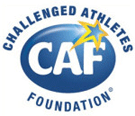While in graduate school at University of Washington, I enrolled in a
triathlon course through the student recreation center. That coach, Aaron Scheidies, turned out to not only be an amazing coach, athlete, and mentor, but was also legally blind. He, like Adrian Broca,
had experienced vision loss during their teenage years, with both
individuals struggling with depression and self-doubt until they turned
to endurance sports as a venue of self-expression and personal
achievement.
Aaron trained me through my first ironman – Vineman
2012. He introduced me to heart-rate based training, periodicity,
intensity versus volume, and generally changed the direction of my life.
While legally blind, he could ride his bike so long as he followed the
white line or rode right behind me. At first, I thought he was totally
crazy, but later I realized that he had to do these things. It’s so true
but so often we don’t realize what we have until we do not have it.
Both Aaron and Adrian, and I suspect many people in their situation,
embody courage and bravery, two traits I highly admire. While inspiring,
I also learn a lot about life by just being around them.
In
fall, 2017, Aaron called me up and asked if I might guide a Los
Angeles-based visually-impaired athlete in Ironman Canada 2018, which is
currently held in Whistler, British Columbia. He described Adrian’s
athletic profile, noting, in particular, that he was a sub-three-hour
marathoner (2:50 PR). In other words, Adrian is a beast. I had a busy
spring with travel for work, so only got to train with Adrian for a
weekend in April/May. We did a 93-mile bike on his tandem in the Santa
Monica Mountains, two-mile swim in the choppy LA ocean, and a nine-mile
run. That session helped us get a feel for one another. In addition,
Adrian’s wife, Brenda, told me I might be the funniest guide they’ve
had, which pleased me greatly.
I had paced several
half-marathons and a marathon, but guiding is obviously much more
involved. With run pacing you just stick to a steady pace (say 6:52 for a
half-marathon); whereas guiding requires constant awareness and
communication (which is the fun in it). Adrian can sense levels of
lightness/darkness and can sort of detect peoples’ positioning say on a
bike trail (which is critical since he’s always burning by everyone). He
described his vision this way: open your eyes in a muddy pond and look
up towards the surface. With these challenges, it was my responsibility
as the guide to adjust to the needs of the guided athlete to ensure
their protection with the goal of letting them reach their athletic
potential.
Swim
The Ironman Canada swim is held
in Alta Lake surrounded by beautiful snow-capped mountains. Challenged
athletes can either start just behind the lead professional athletes or
in their “expected” swim finish time position (ironman and half-ironman
races now usually have a staggered start as opposed to everyone starting
at the same time). With the former you get a bit of a lead on everyone
else, which might help one ease into the race, but then you risk getting
mowed down by faster (and more aggressive) front-pack swimmers. Adrian
opted to start in the staggered pack with everyone else, as he is on the
newer side of swimming, so we situated around the 1:30-40 range.
We
are tethered together around the hip and upper thigh during the swim. I
swim on the left and slightly ahead, he swims on the right just behind.
Adrian can tell where to go when he feels the tension on the cord,
adjusting accordingly throughout the entire 2.4 miles. For the most
part, the swim was not overly crowded, and we only got knocked a bit. We
did get caught up in the 70.3 lead swimmers who started about an hour
after us so I had to keep an eye on all that glancing behind me every so
often. One guy mowed through the center of us and got tangled in the
tether resulting in a ferocious response from me to the likes I didn’t
know I had. But he apologized and obviously he didn’t swim through us on
purpose. But when you are charged with essentially protecting someone
in those conditions your instincts are powerful. Thus, we moved off to
the side and kept swimming all the way through. We exited the swim in
1:42.
T1
Moving into transition
our first task was to hit up the wet suit strippers who help strip your
wetsuit off facilitating your transition to the bike. Honestly, we
cannot thank the volunteers enough. We grabbed our transition bags,
headed into the tent, put on our helmets and bike shoes, got our gear
(Adrian opted for a backpack with two hydration packs to make refueling
at the aid stations easier) then jogged over to our tandem bike. During
this time Adrian would put his hand on my shoulder to make sure he
didn’t trip or fall.
Bike
The Ironman
Canada bike is one of the more grueling bike courses on the ironman
circuit, with 8-9000 feet of total climbing. Bike courses are not equal,
and your time is generally dictated by three things (holding fitness
level constant): temperature, wind/rain, and elevation gain. Ironman
Canada has a ton of climbing, the temperatures got to over 90F towards
the back-half of the ride, and there was some wind (not crazy, but
some). Combining that with a tandem bike that probably climbs about half
the speed I would climb on my own tri-bike made for a long and grueling
bike ride. At one point, someone in running shoes rode by us on one of
the climbs. To make up for “lost” time we descended like maniacs hitting
speeds close to 50mph passing tons of people descending and ascending
in the other direction. Luckily, I do a lot of climbing and descending
so felt generally cautiously comfortable but it must have looked
ridiculous.
The upside was that at least Adrian and I had a good
time making jokes for at least the first 80 miles or so. The other
benefit of a tandem is that all the fans notice and express special
cheers. The amount of times I heard, “hey look, a tandem” were
countless, but the best was: “look at that wicked tandem.” I said to
Adrian, “I think that guy was from Boston”, to which he agreed. Also, I
should add we received lots of encouragement from fellow athletes, which
is small, but helps a lot when you are beginning to struggle.
The
last 30 or so miles for me were a real struggle. The bike positioning
of course is not my normal setup, and I had some challenges with
hydration and nausea. But given the heat it was imperative to continue
taking in liquid, electrolytes, calories, and salt even if that resulted
in the occasional Gatorade burp. The end of the bike in some ways is
the hardest part of an ironman because you are starting to fade, are
generally feeling shitty and sorry for yourself, but begin to dread the
marathon. Our bike split was 7:33.
T2
Coming
into transition we were both elated but shot. However, Adrian is a
solid runner, so I knew we were going to be passing people the whole
way. Moving into the change tent we found seats and began changing into
our running shoes and socks, gathering our running water bottles and the
like. During this time, I tried burping a bit and realized I might need
to puke. So I vomited all that built up liquid (combination of water,
Gatorade, Coke, Red Bull, Perpetuem) into the nearest trash can. No bile
or anything, just enough to get those air bubbles out of the stomach.
Immediately I felt better and we were off on our way to complete what we
had started.
Run
The Ironman
Canada run is a beautiful two loop out and back with a finish in
Whistler village. We began the run during the hottest part of the day
but for two Southern California boys that wasn’t really an excuse. I’ve
trained and raced in significantly worse conditions (e.g., Kona and Palm
Springs). The course has about 1,300 feet of elevation gain so isn’t
“fast” per say, but relative to the bike there were pockets of shade. In
addition, the views were insane: snow-capped mountains, cloudy
turquoise lakes, lush green forests, truly beautiful. We got into a
steady groove but given the crowded bike-trail conditions and run
traffic coming the other way, it was a constant battle of acceleration
and deceleration, navigating turns, moving up short climbs and descents,
and making sure to consume the proper nutrition at each aid station.
While our splits overall may not look that impressive (due to aid
stations, turns, navigating through traffic, etc.), we were running
7:50s-8:30s (per mile) in the open section for a good part of the
marathon feeling more like a 3:40 effort rather than the 4:15 posted
split.
Ironmans are very uncertain events, even top athletes
break and have to walk during the run. Early on, I wondered if Adrian
would crack; at mile 11 he stopped, bent over, and loudly dry-heaved. I
thought maybe this was the moment and that stomach problems would begin
to slow us down. But, like my T2 puke-fest, it was a momentary weakness
and we recovered our running form shortly thereafter. At that point, I
realized Adrian was a true warrior and that we were going to grit this
thing out if it killed us.
We continued one foot after another, runner up, Adrian pass on the left I’d pass on the right. “Adrian, the line is clear, two runners ahead on your left”, etc. “Trail now bending right, now left, look out for that root, there’s a cone, now a sidewalk curb, etc.” At the final turnaround with about five miles to go we picked up the pace and just started trucking. Adrian asked what mile we were at, I said, “Mile 21.” He said, “Wow, that’s awesome.” The final miles were a bit of a blur, but I saw Sarah around the 24.5-mile mark, providing us inspiration. With that extra boost of energy the last bit of adrenaline started to kick in, the kind where you get the sheets of electricity running through your body and your emotions begin to get the better of you. I was so proud of Adrian hanging tough (and me too), and proud to guide someone through such an accomplishment. As we came down the finish line shoot I think both of us were overcome with emotion as the cheering got louder and fans/supporters realized what they were witnessing. We crossed in 13:48, with a total run time of 4:15.
If you are interesting in guiding challenged athletes or learning how to support them you can visit Challenged Athletes Foundation on Facebook or their website.
Tags: iron man canada, ironman





